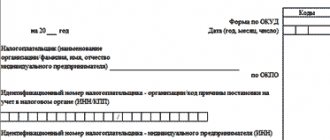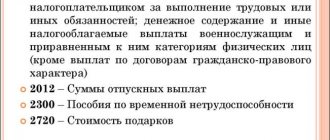Bookmarked: 0
The tax return under the simplified tax system is submitted in a single copy. If you submit it yourself (or through an authorized representative who has a power of attorney to represent your interests at the tax authority), you can create a second copy, and also receive a note from a tax authority employee on one of them that the declaration has been submitted.
Individual entrepreneurs who submit reports under the simplified taxation system (hereinafter abbreviated as simplified tax system) are required to fill out a declaration for the past calendar year and submit it no later than April 30.
You can prepare and submit reports yourself manually or use a special online service.
How to calculate tax
Tax is calculated simply: the tax base is multiplied by the tax rate.
The simplified tax system has two options for calculating the tax base and two rates. They depend on the chosen tax regime.
If your mode is “income”, then your tax base is the sum of your entire entrepreneurial income for the required period. Your tax rate in this case is 6%.
If you chose the “income minus expenses” mode, then the tax base fully corresponds to the name of the mode, that is, it is the difference between all business profits for the required period and the expenses incurred by the business. But there are expenses that the law does not allow to be deducted from the tax base. More information about this is in the Tax Code, namely in Article 346.16. In this mode, the tax rate is 15%.
Regional authorities have the right to lower these rates both for all entrepreneurs and for certain categories.
What indicators to consider
It would seem that entrepreneurs only need to take into account business income in order to submit reports. The main thing is to indicate all amounts on an accrual basis by quarter. But the fact is that the declaration also includes data on insurance premiums and trading fees.
Insurance premiums in the declaration mean several payments at once:
- insurance premiums of individual entrepreneurs for themselves;
- sick leave benefits paid to employees;
- payments under personal insurance contracts.
You can indicate either quarterly or in a single amount for the year. It all depends on how you pay them. For example, if you make contributions every quarter, indicate the exact payment amount for each period. If you pay one time, then the declaration must also contain one amount.
A separate block of the declaration is devoted to the trade tax. This is a local payment for retail trade that is valid in Moscow. Here's who pays it:
- retail outlets without halls (for example, markets, tents, vending machines);
- non-stationary trade points (for example, coffee kiosks);
- retail outlets with trading floors;
- warehouses.
If you have never heard of a trade tax, but work in Moscow in one of the listed areas, carefully study the capital’s tax memo. It contains detailed information about accounting and benefits.
Income from trading fees is accounted for separately. Here's what it looks like in an example. Let's say entrepreneur Daniil opened a small coffee shop of 30 square meters. m in Zelenograd. He sells coffee and baked goods, and also conducts master classes and training for baristas. This is what the table of his income looks like by type of activity for the past year.
If we convert to income on an accrual basis, the table changes slightly.
All this data will be useful when we fill out the declaration.
Tax payment
As an entrepreneur who has chosen a simplified taxation system, you must pay taxes quarterly and submit a report at the end of the year. The tax is paid by you at your place of residence, and this is not the same as organizations that all pay at their location.
So, taxes must be paid once every three months. There is a deadline after which, if you fail to pay, claims will be filed against you - the 25th day of the month following the billing month. A slightly longer period is given for payment at the end of the year - April 30 of the year following the expiration.
If the deadline for paying tax (filing a declaration) falls on a weekend or holiday, it is postponed to the next working day.
You can pay the tax through a bank receipt, or you can pay it cashlessly through a bank account.
Failure to pay taxes is punishable by fines ranging from 20 to 40% of the amount of the calculated but overdue tax.
How to fill out the form
To fill out the declaration, open it through Adobe Acrobat. There are three sections to fill out:
- Title page;
- Section 1.1;
- Section 2.1.1;
- Section 2.1.2.
Section 2.1.2 is completed only by trade tax payers. And if a company or entrepreneur receives budget funding or used state property, they additionally fill out section 3.
If you cannot open the PDF file, use the “Legal Taxpayer” program - you can download it on the tax website. It is only suitable for Windows: the service does not work on smartphones, Linux and MacOS.
Title page
The declaration begins with general information about the entrepreneur or company. You must provide the full name, INN, KPP (for legal entities only) and reporting information. Here are some important rules:
- The correction number is always indicated. If you are submitting your first declaration for the reporting period, write “0−−”. If the tax office returned the form and asked to correct it, please indicate the serial numbers. For example, the first adjustment is “1−−”, the second is “2−−”.
- The tax period is always 34. This means that you submit reports for the previous year. Other periods indicate when a business closes or transitions to OSNO.
- The tax authority code is determined by the place of registration. You can find it on the Federal Tax Service website.
The code for the “location” field depends on the form of business. Individual entrepreneurs indicate “120”, organizations - “214”. Sometimes there are rarer variants.
Do not forget to indicate the name and main OKVED registration exactly as in the Unified State Register of Legal Entities extract. If you write a shortened name, you will have to submit a correction.
The second part of the title page is filled in only in the first column. Individual entrepreneurs indicate the full name, organizations - the full name of the director. But in both cases they put the number “1”.
If the declaration is submitted by a representative under a power of attorney, indicate the number “2”. In the last block of the sheet, indicate the number and date of issue of the power of attorney.
Section 2.1.1
Typically, entrepreneurs fill out section 2.1.1 first, and then 1.1. The fact is that section 2.1.1 includes information about income and the tax base, and section 1.1 includes information about taxes payable. Therefore, it is logical to first calculate the tax base, and then the tax. Here are some rules:
- In the “Taxpayer Identification” block, enter the number “2” if the individual entrepreneur has no employees. In all other cases, enter the number “1”.
- In the “Amount of income received” and “Amount of calculated tax” block, indicate the amounts quarterly on an accrual basis.
The block with the amount of insurance premiums paid is filled in according to the time of actual payment. If you paid for each quarter, indicate the amounts on an accrual basis. If you paid for the whole year at once, then fill out only field 143, and put dashes in the rest.
Section 2.1.2
This section is filled out only by Moscow companies and entrepreneurs who pay the trade fee. If this doesn't apply to you, skip to section 1.1. Section 2.1.2 is filled out in the same way as section 2.1.1, but only income that is subject to tax is taken into account.
In our example with entrepreneur Daniil from Zelenograd, the trade tax is levied on income from the sale of coffee and baked goods, since his premises meet the requirements of the law. First you need to add them up on an accrual basis, and then calculate the taxes that you would pay on this income under the simplified method.
Insurance payments are indicated only for employees who are involved in trading activities. In our case there will be dashes here.
The amount of the fee depends on the area of the outlet and the Moscow region in which it is located. As a rule, the fee is fixed - all amounts are specified in the Moscow law. But in some areas you need to pay extra for each square meter above the norm.
The declaration indicates the amount of the fee actually paid. As a rule, it is paid every quarter. For Daniil’s premises, the fee is fixed - 18,900 rubles per quarter. We add the cumulative total - we get 75,600 rubles for the whole year.
All that remains is to calculate the total amount to be paid. This is done using two formulas:
- Line 130 − Line 140, if the difference between tax and contributions is less than the sales tax. In our example, in the first quarter the tax is lower, but there are no contributions, so in line 160 you need to write 18,000.
- Line 150, if the difference between tax and contributions is greater than the sales tax. In our example, in the second quarter the tax is higher, so in line 161 you need to write 37,800.
Section 1.1
Before filling out the first section, find out the business code according to OKTMO. Previously, the OKTMO code was recognized through the tax service, but now it does not work. But OKTMO is displayed in the Rosstat service. Here's how to find out the code:
- Indicate the TIN of the company or individual entrepreneur.
- Click the "Get" button.
- Copy the code from the “OKTMO registration” line.
In the first section, quarterly amounts of advance payments for taxes are indicated, minus fees and insurance premiums. But now not as a cumulative total, but as an actual one.
The fields in section 1.1 are indicated not by the name of the quarters, but by the deadline for paying advance payments. Here's how to figure them out:
- code 020 - first quarter;
- code 040 - second quarter;
- code 070—third quarter;
- code 100 - fourth quarter.
If you pay a trading fee, be sure to deduct the fee amount for each quarter from your advance payments. In this case, it is better to calculate using the formulas that are indicated in the tooltips for the fields in the form - this way you will definitely not get confused.
Submitting reports
Once a year, as an individual entrepreneur, you must submit a tax return at your place of residence. The deadline for the last annual tax is April 30 of the year following the reporting year.
Violations are punishable: if you are delayed in submitting your declaration for more than 10 working days, the tax office will freeze your current account. There will also be monetary fines, and to them you must add a penny for each missed day.
The declaration can be submitted to the tax office:
— personally;
- through a proxy, having notarized a power of attorney;
- by mail, sending a letter with declared value;
- electronically, if you have an electronic signature.
Reporting is submitted on a special form - KND form 1152017.
Rule five - the declaration must be numbered
All pages of your tax return must be numbered. The title page is also numbered. The pages are numbered in order, even if you skip some sections because they do not apply to you in your tax system. Missing pages are not counted. What is given out is numbered.
Rule six - no stamp required
The declaration under the simplified tax system is submitted without a stamp, even if you, as an individual entrepreneur, have one. Only the manager’s signature is required on the title page, since there is no space for printing (the “MP” field is missing).
Declaration according to the simplified tax system for the quarter
In general, there is only one declaration to be submitted – an annual one. But it happens that the declaration needs to be submitted in just one quarter. This is done if a company or individual entrepreneur began operations in one quarter and completed them in the same quarter. Let's face it, this is rare. In this case, the declaration is submitted on the annual declaration form, but data on income and expenses will be entered only for the quarter in which the company operated.
According to the simplified tax system, what you have to do quarterly is pay a single tax. Every quarter, organizations and entrepreneurs are required to transfer advance tax payments to the Federal Tax Service by the 25th of the next month. Deadlines may vary if the last day of delivery falls on a weekend or holiday. In 2021 the deadlines are as follows:
- tax for 2021 - until March 31, 2021 for organizations and until April 30 for individual entrepreneurs;
- for the 1st quarter of 2021 - April 26;
- for the 2nd quarter of 2021 - July 26;
- for the 3rd quarter of 2021 - October 25;
- the balance of tax for 2021 is until March 31 for organizations and until May 4 for individual entrepreneurs.








